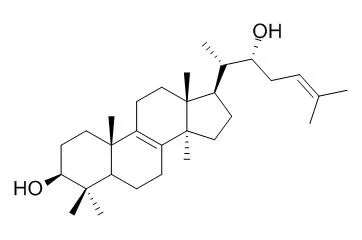| Description: |
Inotodiol shows significant anti-tumor and anti-tumor promoting activities, including human cervical cancer, it inhibits cell proliferation through apoptosis induction by activating caspase-3. Inotodiol can inhibit proliferation and induce the apoptosis of A549 cells, and its molecular mechanism may be associated with the up-regulating expression of p53 and bax proteins and down-regulating expression of Bcl-2 protein, which arrested A549 cells in S phase. |
| Targets: |
Bcl-2/Bax | Caspase | p53 |
| In vitro: |
| Asian Pac J Cancer Prev. 2014;15(7):3195-9. | | Inotodiol inhabits proliferation and induces apoptosis through modulating expression of cyclinE, p27, bcl-2, and bax in human cervical cancer HeLa cells.[Pubmed: 24815470] | Inotodiol, an included triterpenoid shows significant anti-tumor effect. However, the mechanisms have not been well documented. In this study, we aimed to explore the effect of Inotodiol on proliferation and apoptosis in human cervical cancer HeLa cells and investigated the underlying molecular mechanisms. HeLa cells were treated with different concentrations of Inotodiol.
METHODS AND RESULTS:
The MTT assay was used to evaluate cell proliferating ability, flow cytometry (FCM) was employed for cell cycle analysis and cell apoptosis, while expression of cyclinE, p27, bcl-2 and bax was detected by immunocytochemistry. Proliferation of HeLa cells was inhibited by Inotodiolin a dose-dependent manner at 24h (r=0.9999, p<0.01). A sub-G1 peak (apoptotic cells) of HeLa cells was detected after treatment and the apoptosis rate with the concentration and longer incubation time (r=1.0, p<0.01), while the percentage of cells in S phase and G2/M phase decreased significantly. Immunocytochemistry assay showed that the expression of cyclin E and bcl-2 in the treated cells significantly decreased, while the expression of p27 and bax obviously increased, compared with the control group (p<0.05).
CONCLUSIONS:
The results of our research indicate that Inotodiol isolated from Inonotus obliquus inhibited the proliferation of HeLa cells and induced apoptosis in vitro. The mechanisms may be related to promoting apoptosis through increasing the expression of bax and cutting bcl-2 and affecting the cell cycle by down-regulation the expression of cyclin E and up-regulation of p27. The results further indicate the potential value of Inotodiol for treatment of human cervical cancer. |
|
| In vivo: |
| Anticancer Res. 2008 Sep-Oct;28(5A):2691-6. | | Inotodiol, a lanostane triterpenoid, from Inonotus obliquus inhibits cell proliferation through caspase-3-dependent apoptosis.[Pubmed: 19035296] | To investigate the antitumor effect of Inonotus obliquus Pilat, the antiproliferative effect of lanostane triterpenoids from a chloroform extract of I. obliquus sclerotia against mouse leukemia P388 cells was assessed.
METHODS AND RESULTS:
Cell viability was measured by MTT assay. Caspase-3/7 activity and DNA fragmentation were evaluated to analyze apoptosis induction. The in vivo antitumor effect was evaluated by the number of survival days of mouse leukemia P388-bearing female CDF1 mice.
The chloroform extract of I. obliquus sclerotia inhibited proliferation of the P388 cells. Among the triterpenoids examined, only Inotodiol inhibited P388 cell proliferation. DNA fragmentation and caspase-3/7 activation were observed in the P388 cells treated with Inotodiol (30 microM). A caspase-3 inhibitor, DEVD-CHO (N-acetyl-Asp-Glu-Val-Asp-al, 100 microM) partially inhibited the DNA fragmentation and growth-inhibition induced by Inotodiol. The intraperitoneal administration of 10 mg/kg Inotodiol prolonged the number of survival days of the P388-bearing mice.
CONCLUSIONS:
Inotodiol inhibits cell proliferation through apoptosis induction by activating caspase-3. | | Bioorg Med Chem. 2007 Jan 1;15(1):257-64. | | Structure determination of inonotsuoxides A and B and in vivo anti-tumor promoting activity of inotodiol from the sclerotia of Inonotus obliquus.[Pubmed: 17049251] |
METHODS AND RESULTS:
Two new lanostane-type triterpenoids, inonotsuoxides A (1) and B (2) along with three known lanostane-type triterpenoids, Inotodiol (3), trametenolic acid (4), and lanosterol (5), were isolated from the sclerotia of Inonotus obliquus (Pers.: Fr.) (Japanese name: Kabanoanakake) (Russian name: Chaga). The most abundant triterpene, Inotodiol (3), was investigated for the inhibitory effect in a two-stage carcinogenesis test on mouse skin using 7,12-dimethylbenz[a]anthracene (DMBA) as an initiator and TPA as a promoter.
CONCLUSIONS:
Compound 3 was found to exhibit the potent anti-tumor promoting activity in the in vivo carcinogenesis test. |
|






 Cell. 2018 Jan 11;172(1-2):249-261.e12. doi: 10.1016/j.cell.2017.12.019.IF=36.216(2019)
Cell. 2018 Jan 11;172(1-2):249-261.e12. doi: 10.1016/j.cell.2017.12.019.IF=36.216(2019) Cell Metab. 2020 Mar 3;31(3):534-548.e5. doi: 10.1016/j.cmet.2020.01.002.IF=22.415(2019)
Cell Metab. 2020 Mar 3;31(3):534-548.e5. doi: 10.1016/j.cmet.2020.01.002.IF=22.415(2019) Mol Cell. 2017 Nov 16;68(4):673-685.e6. doi: 10.1016/j.molcel.2017.10.022.IF=14.548(2019)
Mol Cell. 2017 Nov 16;68(4):673-685.e6. doi: 10.1016/j.molcel.2017.10.022.IF=14.548(2019)